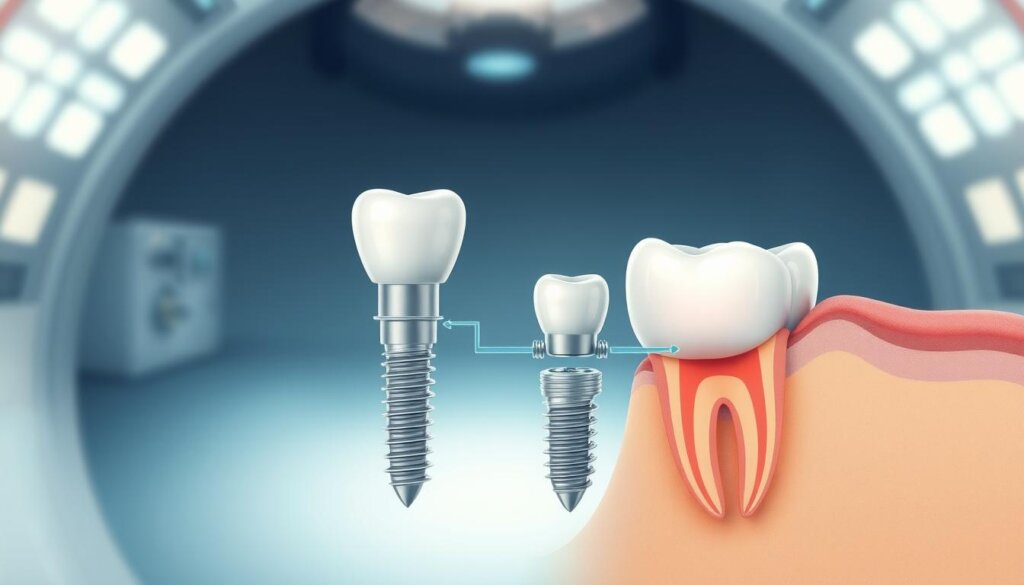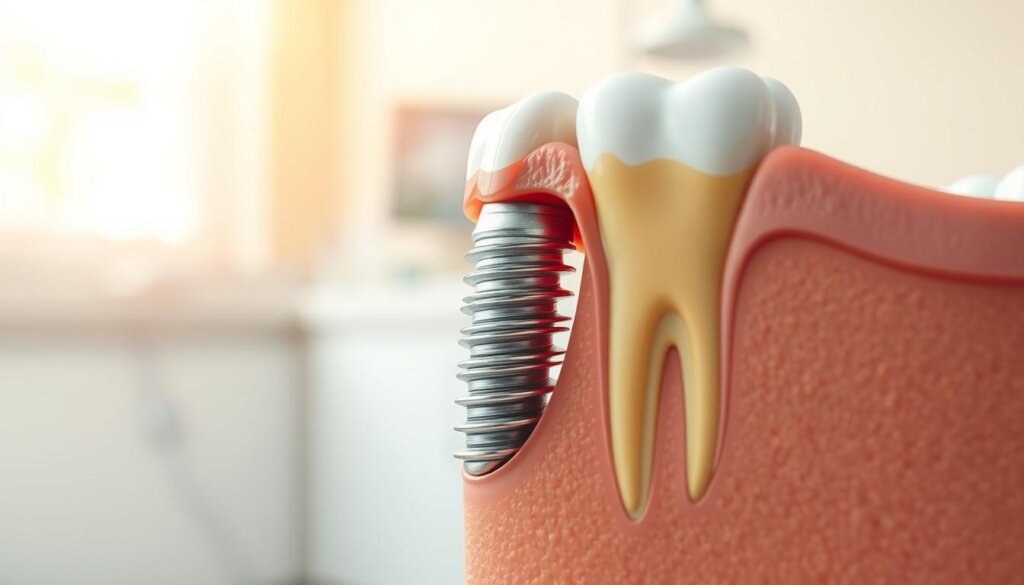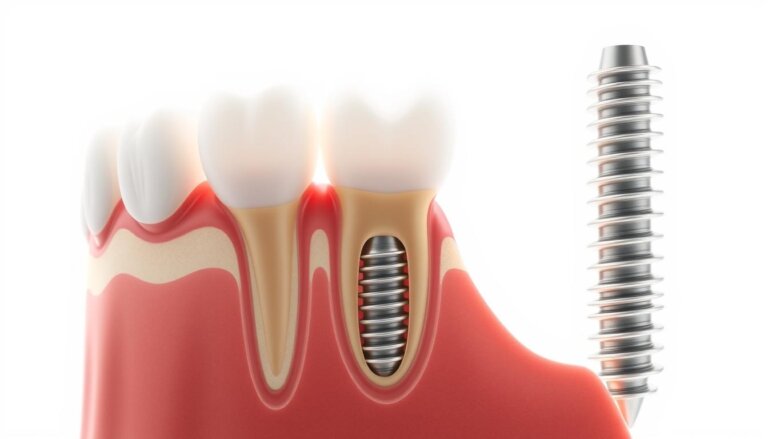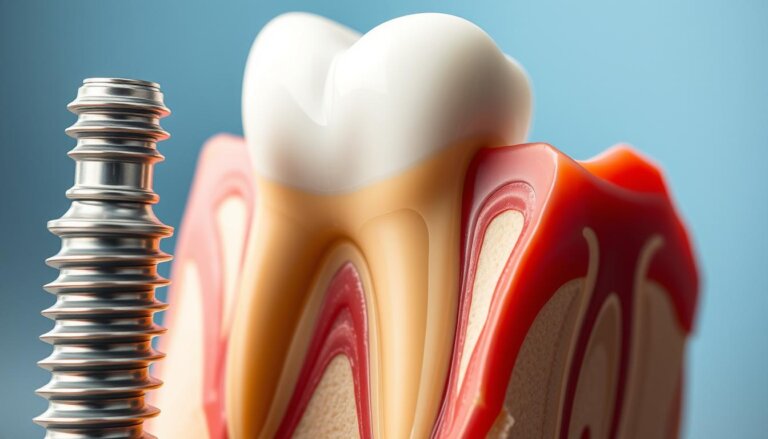How is a Tooth Implant Placed in the Mouth?
Over 3 million Americans have tooth implants, and this number grows by 500,000 each year. This shows how much people trust this dental fix. The tooth implant procedure changes lives through advanced restorative dentistry. It is key for both patients and doctors to know how tooth implants are correctly put in place. This process not only makes smiles look real again but also makes them work like natural teeth.
Placing a dental implant the right way needs careful planning and a deep knowledge of the mouth’s structure. A titanium post is placed into the jawbone during surgery, which acts as a new root for the crown. This brings back the mouth’s original structure. This detailed tooth implant procedure includes planning, the actual placing, and a healing period. This is to make sure the implant lasts a long time. Now, one might wonder, “how is a tooth implant placed in the mouth?” This guide goes through every step, from the first meeting to placing the final crown.
Key Takeaways
- Understanding the significant increase in the popularity and reliance on tooth implants in the United States.
- Recognition of the multi-stage, patient-specific tooth implant procedure.
- Insight into how the dental implant process mirrors the function and appearance of natural teeth.
- In-depth overview of the stages involved in how a tooth implant is placed in the mouth.
- Appreciating the intricacies of the dental implant process, including the importance of a carefully managed healing period.
Understanding Tooth Implants
Tooth implants are a big part of today’s dental care. They offer a lasting fix for missing teeth. Before diving into the details, knowing what a tooth implant is and its benefits can help people make smart choices about their teeth.
What Is a Tooth Implant?
A tooth implant is a sturdy, small piece, usually titanium, acting as a root for missing teeth. It fits into the jawbone, creating a strong support for crowns, bridges, or dentures. The key to its success is how well it fuses with the bone, a process called osseointegration.
Benefits of Tooth Implants
Dental implants have lots of pluses. They look and feel like real teeth, improving how we look and eat. Unlike traditional dentures, you don’t have to take them out to clean or use glue. They also help keep the jawbone healthy by preventing it from shrinking after teeth are lost. Dental implant surgery is reliable, improving life quality.
For the best outcome with dental implants, patients need to be healthy. They must have enough bone and no conditions that slow bone healing. Success depends on careful planning, skilled surgery, and following care instructions well.
The Importance of Dental Consultation
The journey to a successful dental implant surgery starts with an important step: the consultation. This first meeting lays the groundwork for everything that follows. It makes sure every patient gets what they need.
A team of experts, including an oral surgeon and others, checks the patient’s mouth health during the consultation. This careful check is key to making the implant process fit each person.
Initial Assessment
They review medical and dental histories, looking at any health issues that could impact the surgery. This ensures the planning is safe and on point for the dental implant surgery.
X-Rays and Imaging
Dental X-rays and 3D scans are used to clearly see the jaw and teeth. This info is vital for customizing the implant and foreseeing likely challenges in the process.
The detailed consultation highlights the dedication to careful, patient-focused care in implants. This careful planning allows doctors to create targeted, effective treatment plans. These plans meet the specific needs of each patient.
Preparing for Tooth Implant Surgery
Getting ready for tooth implant surgery is key. It’s important to learn about the steps before surgery and the anesthesia kinds. This helps make the surgery comfortable and less scary.
Before surgery day, there are special rules to follow. These can include not eating for a set time and changing your medicine. It’s also advised to quit smoking early to heal better after surgery.
Let’s look at the anesthesia usually used for this surgery:
- Local Anesthesia: Numbs the spot of the surgery so you don’t feel pain.
- Sedation: Makes you more relaxed with pills or IV drugs, used with local anesthesia.
- General Anesthesia: For tough cases, makes you sleep deeply and not aware during the surgery.
After getting any anesthesia, plan for someone to drive you home. You should rest and not do hard activities for the rest of the day. Some may need antibiotics before surgery to avoid infections.
Following these steps and advice can help your surgery and recovery go more smoothly.
The Tooth Implant Placement Process
Putting in a tooth implant shows how advanced dental technology has become. It involves dental implant surgery steps that help bring back both the look and function of your mouth. This is done as an outpatient procedure. Every step is done with extreme care and skill for the best results.
Step 1: Incision of the Gum
The steps for dental implant start with a careful cut in the gum. This lets the surgeon reach the bone where the implant goes. This is the first key step in the surgery.
Step 2: Drilling the Implant Site
Next, they expose the bone and get it ready for the implant. They drill a very small hole in the right spot. Getting the angle and depth right is super important for the implant to work well.
Step 3: Placing the Implant
After that, they put in the implant— a fake tooth root, often made of titanium— into the bone. It’s crucial that the implant is secure. It needs to hold up the fake tooth well.
Then, a temporary tooth can be put in for looks while everything heals. Over months, the bone will grow around the implant. This growth, called osseointegration, is key for the implant’s stability.
The dental implant surgery steps make sure patients get their smile, chewing, and speaking abilities back. Every step is done carefully to prevent problems and make the implant last a long time.
Post-Placement Healing
After getting a dental implant, there’s a crucial healing phase. This phase is key to the implant’s success. It involves handling usual post-surgery problems. Also, it’s important to go to follow-up checks. These ensure the implant integrates well with the jawbone.
Initial Recovery Phase: The first days post-surgery are important for healing well and feeling comfortable. Patients might face swelling, a bit of bleeding, and discomfort. These symptoms are normal. Doctors usually give medicines for pain and to stop infections. They also suggest eating soft foods to ease stress on the implant.
Importance of Follow-Up Appointments: After recovery begins, follow-up appointments are key. They let doctors check how well the implant and jawbone are merging. These visits ensure the implant fits right and allow for any needed tweaks. This is when doctors take out any stitches that don’t dissolve on their own and tackle any concerns quickly.
Understanding and following the implant timeline is vital. It ensures the implant works well for a long time.
Osseointegration Explained
Osseointegration is crucial in the tooth implant placement process. It’s when the implant and jawbone join together. This phase is key for the implant’s stability and function. It shows how important bone growth and healing are.
This complex biological process starts right after placing the implant in the jawbone. Over time, the bone cells cover the implant’s surface. This ensures the implant becomes a permanent part of the jaw.
Let’s look more closely at what makes this phase important:
- Duration of Osseointegration: The time it takes to fully integrate can differ. It usually takes several months and depends on the person’s health and jawbone quality.
- Factors Influencing Osseointegration: Many things affect how well osseointegration works. These include the patient’s bone density, where the implant is placed, and their overall health.
Knowing the details of osseointegration helps improve the tooth implant placement process‘s success rate.
With a better understanding of this process, patients can appreciate the need for time and care in bone growth and healing. This helps their implants last longer and work better.
Abutment Placement
The stage of placing an abutment is a big step in getting dental implants. It involves adding a connector called the abutment. This part holds the dental crown. After the implant joins the bone, through a process known as osseointegration, this step is done.
What Is an Abutment?
An abutment is a crucial small part of the dental implant procedure. It connects the dental implant in the jawbone to the crown that everyone sees. It keeps the crown stable, making sure the new tooth lasts a long time.
The Procedure for Abutment Placement
After osseointegration, putting in the abutment might need another surgery. During this, the gum is opened up to show the implant. Next, the abutment is attached to the implant. The gum is then stitched around it, with part of the abutment sticking out. This makes it ready to hold the crown tightly.
Sometimes, the abutment is put in at the same time as the implant. This can make the whole process quicker by skipping a second surgery. But, this means the abutment might be seen above the gum before the crown is added.
Attaching the Crown
Getting a dental implant finished involves a key step: adding the artificial tooth. This happens when the implant’s base merges fully with the jaw. It ensures the new tooth works well and looks good.
Types of Crowns Available
Different crowns are crucial for implant success. They vary from those you can remove to ones that stay put, meeting various needs. Removable ones are like dentures and can be cleaned easily. Meanwhile, fixed crowns are attached firmly, acting like real teeth.
The Final Fitting Process
Putting in the crown is the last step. Measurements and impressions make sure the crown fits perfectly and looks natural. The crown is then secured to the implant, making the tooth look and work like new.
| Type of Crown | Description | Benefits |
|---|---|---|
| Removable | Can be detached for cleaning and maintenance | Easy to clean; can be adjusted or replaced without surgery |
| Fixed | Permanently attached to the implant | Feels and functions like natural teeth; no need for daily removal |
Possible Complications
Dental implants come with big benefits, but it’s key to talk about the dental implant complications and implant surgery risks. Knowing these can help you make a smart choice. It also gets you ready for the best outcome.
Infection risks and chances of implant failure are big worries with dental implants. Even though these issues don’t happen much, they’re important to think about.
- Infection Risks: Infections can happen where the implant is placed. This might make recovery longer. Sometimes, you might need more treatment to get rid of the infection.
- Implant Failure Factors: For implants to work, they need to join with your jawbone in a process called osseointegration. But, not enough bone, smoking, or certain illnesses can make this process fail.
These points show the risks that come with implant surgery. Even though new techniques and checking everything before surgery lower these risks, they can’t take them away completely.
Cost of Tooth Implants
When thinking about getting tooth implants, people often worry about the cost and what the surgery will involve. It’s a big financial decision, but knowing all the details can make it easier to decide.
Factors Influencing Cost
- Complexity of the procedure: More complex cases require additional resources which elevate costs.
- Number of teeth being replaced: Single tooth replacements cost less than multiple or full-mouth implants.
- Additional treatments: Procedures like bone grafting are sometimes necessary and increase overall expenses.
Insurance Coverage and Financing Options
Insurance for dental implants differs, with some plans covering part of the cost. It’s critical to talk to your insurance provider to see what parts of the tooth implant surgery they’ll pay for. If the dental implant price seems too much, there are ways to make it easier to pay. Many dental offices have payment plans, spreading the cost over time. This makes getting implants possible for more people.
The cost at the beginning can be scary, but dental implants are worth it in the long run. They last a long time and work really well, making them a good investment.
Alternative Tooth Replacement Options
Dental implants are a well-known way to replace missing teeth. Yet, some people might find other options like dentures and bridges more fitting. These alternatives come with their own benefits and considerations.
Dentures and bridges are key alternatives to dental implants. They each have pros and cons. This depends on oral health, what the patient wants, and budget.
| Feature | Dentures | Bridges |
|---|---|---|
| Dependency on Adjacent Teeth | Not required | Required |
| Prevent Bone Loss | No | No |
| Procedure Complexity | Less complex | Moderate |
| Longevity | 5-8 years | 10-15 years |
| Cost | Generally less expensive | More expensive than dentures, less than implants |
When picking the right tooth replacement, think about the long-term pros and cons. Dentures cost less upfront and you can take them out. But, they may not stay in place well, which can make eating and talking hard. On the other hand, bridges are more stable and feel natural. Yet, they need changing nearby healthy teeth and don’t stop bone loss.
Making a choice between dental implant alternatives should happen after talking to a dentist. They can look at your health and needs. Knowing your options well helps you make a choice you’re happy with. This leads to better satisfaction and dental health.
Oral Care After Implant Placement
Right after getting dental implants, it’s key to focus on dental care post-implant surgery. Good hygiene and regular dental visits are a must. These steps help prevent problems and make sure the implant works well.
- Daily brushing with a soft-bristled toothbrush to prevent scratching the implant surface.
- Flossing at least once a day using unwaxed tape or implant-specific floss to avoid damaging the tissue around the implant.
- Rinsing with a non-alcoholic antimicrobial mouthwash to reduce bacteria buildup.
- Avoiding habits such as smoking, which significantly impedes the healing process and increases the risk of implant failure.
Regular dental visits are important, usually every six months. They let dentists check the implant and the surrounding area. It’s also a chance for a professional cleaning.
By following your dentist’s advice after surgery, you can keep your implants strong and your smile bright. This helps maintain a healthy mouth.
Long-Term Maintenance of Implants
Keeping tooth implant longevity at its best is key for making dental implants last. This means using smart dental implant care tactics. These help keep both the implants and the mouth healthy.
Importance of Oral Health
Good oral health is vital for implant life. It includes both regular care and knowing how cleanliness affects implant success. It’s all about preventing diseases around the implant, which can damage it.
Maintenance Tips
To care for your dental implants, follow these steps:
- Brush around implants with soft-bristled brushes to avoid scratches.
- Use special brushes and floss for implants to get rid of plaque and bits.
- Don’t chew hard things or smoke since they can harm your implants.
- Go to the dentist every six months to keep implants in check, and, if needed, tweak how you take care of them.
By sticking to these suggestions, you’ll keep your tooth implant longevity up and keep your mouth healthy. Keeping up with regular dentist visits and your daily cleaning routine are the main parts of a good dental implant care plan. This plan keeps your implants looking and working great.
| Component | Daily Care | Professional Care |
|---|---|---|
| Dental Implants | Brushing and use of interdental brushes | Bi-annual professional cleaning and check-up |
| Natural Teeth | Brushing, flossing and fluoride rinse | Annual X-rays and exams to monitor overall oral health |
Learning and doing proper dental implant care means your implants will last longer. This leads to a healthy, great-looking smile for a long time.
Success Rates of Tooth Implants
Thanks to new steps in regenerative medicine and dental tech, tooth implant success is way up. It’s now a top choice for those missing teeth. People get back not just the use of their teeth, but also the confidence in their smiles.
Many things play a part in how well dental implants work. Choosing the right patients is key. Ideal candidates are generally healthy, have enough bone density, and don’t have conditions that slow down bone healing. Also, how skilled the dental team is makes a big difference in dental implant effectiveness.
| Factor | Impact on Success |
|---|---|
| Patient’s Oral Hygiene | Higher success rates in patients who maintain good oral hygiene post-implant |
| Professional Expertise | Direct correlation between the skill level of the dental team and implant success rates |
| Health and Lifestyle Choices | Non-smokers and those without chronic illnesses such as diabetes show higher success rates |
| Quality of Implant Material | Use of advanced, biocompatible materials contributes significantly to long-term success |
Looking at the future of tooth implant success, things look really good with the right care. New techniques and better materials not only keep but boost dental implant effectiveness. Staying away from smoking and following oral health tips can help people enjoy their implants for a long time.
Frequently Asked Questions
When thinking about tooth implants, many people have questions. They also want to know the real facts about dental implants. Talking about these topics can make things clearer. It can help with worries and bust some myths about the process.
| Common Concerns About Tooth Implants | Myths and Facts About Implants |
|---|---|
| Will the procedure be painful? | Myth: Implants are noticeably different from natural teeth. |
| What are the success rates of implants? | Fact: Implants blend seamlessly with natural teeth when properly placed. |
| Do implants look natural? | Myth: Surgery for implants is excessively painful. |
| What is involved in post-operative care? | Fact: With adequate anesthesia, the discomfort during surgery is well-managed. |
| It’s crucial for patients to follow post-surgical care to see optimal results and ensure a long lifespan of their tooth implants. | |
Finding a Qualified Dentist
Choosing the right dental professional is key for a successful tooth implant. A qualified dental implant dentist brings high care standards. They ensure the best results. It’s vital to check the dentist’s implant dentistry skills. This field requires complex surgical and restorative skills.
Important traits and qualifications for a tooth implant professional include:
- Credentials in implant dentistry that show advanced training and skill.
- Years of experience in the dental implant sector.
- Positive feedback from patients that show happiness and success.
- A commitment to learning about new implant technology and methods.
These elements help a dentist give safe and effective treatment. Choosing someone who works with specialists like periodontists and prosthodontists is wise. It makes the implant procedure better and more effective.
| Qualification | Details | Importance |
|---|---|---|
| Accredited Education | Graduate of an accredited dental school with specialized training in implantology. | This background ensures knowledge and hands-on skills in dental surgery and implants. |
| Professional Experience | Plenty of experience particularly with implants. | Experience allows a dentist to manage complex situations and surprises well. |
| Continuing Education | Courses on the newest implant methods and materials. | Staying informed on implant dentistry’s latest trends benefits the patient greatly. |
| Patient Feedback | Reviews from past patients. | Feedback shows the dentist’s ability and success in implantology. |
Conclusion
Getting a tooth implant involves careful planning and accuracy. We looked at tooth implant surgery, going over each part thoroughly. From the first dental check-up to post-surgery care, we’ve covered it all together.
Recap of the Tooth Implant Process
The tooth implant process begins with a detailed examination. Then, the implant gets placed into the jawbone. Finally, the crown is added on top. This process offers sturdy, functional, and good-looking teeth, better than other options.
Encouragement for Seeking Professional Advice
If you’re thinking about dental implants, it’s critical to talk to dental experts. They help you understand the process fully and what you need to commit to. Our goal is to push forward medical science and teach everyone clearly. This helps you make the best choices for your teeth and health.




